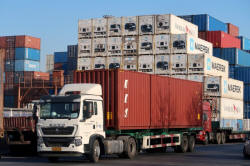China's Sept exports surprisingly robust despite power crunch
 Send a link to a friend
Send a link to a friend
 [October 13, 2021] By
Stella Qiu and Gabriel Crossley [October 13, 2021] By
Stella Qiu and Gabriel Crossley
BEIJING (Reuters) - China's export growth
unexpectedly accelerated in September, as still solid global demand
offset some of the pressures on factories from power shortages, supply
bottlenecks and a resurgence of domestic COVID-19 cases.
The world's second-largest economy has staged an impressive rebound from
the pandemic but there are signs the recovery is losing steam. Resilient
exports could provide a buffer against growing headwinds including
weakening factory activity, persistently soft consumption and a slowing
property sector.
Outbound shipments in September jumped 28.1% from a year earlier, up
from a 25.6% gain in August. Analysts polled by Reuters had forecast
growth would ease to 21%.
"Exports have continued to outperform and accelerate, even after
omitting the impact of base effects," said Erin Xin, Greater China
economist at HSBC, adding that earlier shipments of holiday consumer
products in light of global supply chain disruptions may be behind the
continued strength in exports.
Other analysts said power rationing in September may not have affected
exports yet, but could constrain production and inflate costs for
Chinese manufacturers in the months to come.
Power shortages caused by a transition to clean energy, strong
industrial demand, and high commodity prices have halted production at
numerous factories including many supplying firms such as Apple and
Tesla since late September.
Factories in eastern provinces of Guangdong and Zhejiang, both major
export powerhouses, have been asked to stagger their production
throughout the week, and many owners are complaining about the chaos the
curbs have brought to work schedules.
Previously, factories could operate at night but now the ban is 24 hours
on days of rationing, said King Lau, who helps manage a metal-coating
factory in the export city of Dongguan. The factory was asked to stop
using government electricity on three working days this week.

However, Louis Kuijs, head of Asia economics at Oxford Economics is
optimistic the export outlook in the coming quarters remains solid,
despite near-term headwinds.
"We generally expect these disruptions to ease over the coming months,
as we expect senior policymakers to stress growth and to call for the
pursuit of climate targets on a more measured timeline."
"Further out, we think exports should be underpinned by the ongoing
global economic recovery and a gradual easing of global supply-chain
disruptions next year."
[to top of second column] |

A worker drives a truck carrying a container at a logistics center
near Tianjin port, in Tianjin, China December 12, 2019. REUTERS/Yilei
Sun/File Photo

Recent data has pointed to a slowdown in production activity. China's
manufacturing PMI unexpectedly shrank in September as industrial firms battled
with rising costs and electricity rationing.
Furthermore, the property sector, a key driver of growth, is reeling from the
increasing defaults of Chinese developers, with real estate sales tumbling and
new construction starts slowing.
Reuters latest poll shows analysts have lowered their expectations for China's
full-year growth to 8.2% from 8.6% seen in July, with a further slowdown to 5.5%
in 2022. On a quarterly bsis, growth in the third quarter might have cooled to
just 0.5% from 1.3% in April-June.[ECILT/CN]

But analysts said concerns over high debt levels and property bubble risks may
delay any further central bank policy easing into next year.
Many analysts are expecting the central bank to inject more stimulus by cutting
the amount of cash banks must hold as reserves to help small and medium-sized
enterprises.
IMPORTS SLOW
China's September imports rose 17.6%, lagging an expected 20% gain in a Reuters
poll and 33.1% growth the previous month.
"The breakdown showed a broad-based decline across all good types, though it was
particularly pronounced for inbound shipments of semiconductors," said Julian
Evans-Pritchard, senior China economist at Capital Economics.
"Lower import volumes of industrial metals add to evidence that environmental
curbs and cooling construction activity are weighing on heavy industry."
However, China's energy demand is rapidly rising.
Coal imports in September rose to the highest this year as power plants
scrambled for fuel to boost electricity generation to ease the power crunch and
replenish inventories ahead of the winter heating season.
Natural gas imports in September also rose to their highest since January this
year.
China posted a trade surplus of $66.76 billion in September, versus the poll's
forecast for a $46.8 billion surplus and $58.34 billion surplus in August.
Its trade surplus with the United States rose to $42 billion, Reuters
calculations based on the customs data showed, up from $37.68 billion in August.
(Additional reporting by Colin Qian; Editing by Jacqueline Wong)
[© 2021 Thomson Reuters. All rights
reserved.] Copyright 2021 Reuters. All rights reserved. This material may not be published,
broadcast, rewritten or redistributed.
Thompson Reuters is solely responsible for this content. |